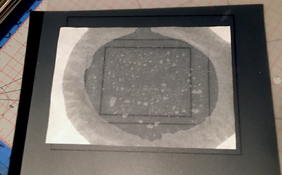Thanks

Far left and far right are the same paper, which is just a cheap 230 gsm hot-press watercolour paper re-branded by the local art store (the store is called Gordon Harris, but they don't make the paper). It's great because it basically doesn't stain, but unfortunately they seem to have changed paper supplier or something recently because the new paper doesn't print anywhere near as nicely and has a weird linear texture to it.
The middle two prints are a different paper I'm trying. They're Fluid brand hot-press 300 gsm watercolour paper. It prints really nice with a super smooth tonal range, but unfortunately stains a lot more than the cheap store-brand stuff. Still acceptable I think, would look fine with a cream coloured matt board when framed.
My process is to wait at least a day after printing the cyanotype, pre-soak in water for a few minutes then lay the print face down in coffee for 30 minutes before washing, no bleaching. The coffee mix is 6 tablespoons of instant in 3 litres of water (I do a few prints at once). Whether the paper stains a lot or not seems entirely dependent on the paper, and I assume how it's sized and with what. I wish the fluid paper had whatever the store brand stuff has that makes it stain-free as it really is much nicer paper.















